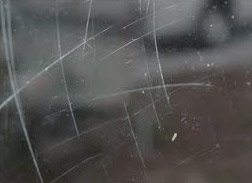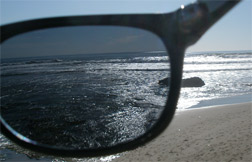There are two primary materials used when making sunglass lenses: glass and polycarbonate. Polycarbonate is the newer innovation of the two. Glass is the older option and at one point, it was the only way to make glasses. There are other plastics used to make sunglasses, but they’re less common than polycarbonate.
Plastic Shine
Polycarbonate lenses feel like plastic and are very lightweight. For this reason, they’re an alternative to heavy glass lenses, and they’re much less likely to shatter and cause injury to the eyes or face. They are also inexpensive to make, and can be produced in a variety of sizes from thin to fairly thick.
Manufacturers don’t lose any precision with the less expensive material either. The majority of lenses on the market today, like the lenses on the Maui Jim Kanaha (reviewed here) are made out of polycarbonate material.
 The biggest issue with polycarbonate lenses is they’re not naturally scratch resistant. Without a scratch proof coating (that can increase the cost of the lens), you will have to be pretty careful if you want them to last. You’re a lot less likely to get injured if they break, but they do become hard to see through even with just one scratch on the lens. While they still offer good visual precision, they’re not quite as good as other options out there.
The biggest issue with polycarbonate lenses is they’re not naturally scratch resistant. Without a scratch proof coating (that can increase the cost of the lens), you will have to be pretty careful if you want them to last. You’re a lot less likely to get injured if they break, but they do become hard to see through even with just one scratch on the lens. While they still offer good visual precision, they’re not quite as good as other options out there.
Glassy Eyed In A Good Way
Glass is the original material used for making sunglasses before plastic or polycarbonate became an option. They offer incredible visual clarity, and they’re difficult to scratch. Glasses like the Maui Jim Stingray feature glass lenses.
While glass may be widely considered the superior material, it is the more frustrating of the two for a few reasons. Glass is heavier, making it difficult to wear on small faces. It’s also breakable, and can shatter after an impact. That being said, it’s incredibly rare for a pair of sunglasses made by a reputable manufacturer to completely shatter.
Beyond Glass And Plastic
High-end polyurethane is the most expensive lens option. It’s very durable and offers great visual clarity, but you will definitely pay more for it. It’s very lightweight, and offers the best of both worlds.
Acrylic lenses are the least expensive, and they don’t offer a whole lot of protection or clarity. They’re not recommended for regular use, but they’re not bad for glasses that are more “fashion” than “function”.
Get Tinted
The color of your lenses is more than just a fashion statement. Different tints offer various alternatives with regards to your visual field, and you should know what’s going to be affected when you pick up those shades.

See Yourself in Mirrored Lenses.
Many pairs of aviator sunglasses are mirrored, and they look like a fashion statement rather than eye protection. Mirrored glasses however, offer an alternative to polarization by deflecting the majority of glare away from the eyes. In general, mirrored lenses have a darker tint. Dark mirrored lenses can be hard to see through, so unless you’re likely to be in VERY bright light you might want to consider something lighter.
Yellows
If you’re like me, you’ve never considered a pair of yellow, orange or bronze-like lenses for any reason. It’s just not my cup of tea. That being said, there are reasons to pick glasses with a yellowish tint. If you’re going to be in a situation that isn’t extremely bright but still requires sun protection, a yellow hue could do the trick. They’re also good for sports because they increase visual perception as well as protecting your eyes.
Reds
Glasses that offer a red color are best in cloudy or overcast situations. Even though it isn’t bright, you may still require glasses to protect your eyes from UV rays. We tend to ignore overcast days because we think the sun is being blocked, but the rays still get through. When the light outside is dim, lenses with a red tint can actually brighten it up.
Neutrals
If it looks like an autumn color, it falls under this category. Colors like browns, greens and grays do a good job of combating bright light. Better yet, they don’t change the way colors look when you peer at them through the lenses. They basically provide protection without distortion.
Polarization
 Polarized lenses often have a coating that provides them with the ability to neutralize glare. You can read more about polarized lens options here.
Polarized lenses often have a coating that provides them with the ability to neutralize glare. You can read more about polarized lens options here.
Anti-scratch coatings
Although they can come in a variety of names, coatings that are there to ward off scratches are typically needed for polycarbonate lenses because they have the highest tendency to scratch. These protective coatings can significantly extend the life of your sunglasses, but do your homework and find ones that protect the way they say they can.
Lenses For Everyone
Each option makes a huge difference to the type of sunglasses you end up selecting. You just have to figure out if you need additional protection like scratch resistance or a tint for special situations. Remember that glass is for “sturdy” and polycarbonate is for reliability.


